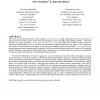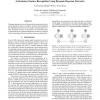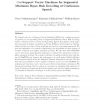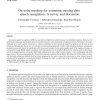CSL
2007
Springer
13 years 11 months ago
2007
Springer
Determining the position of breaks in a sentence is a key task for a text-to-speech (TTS) system. We describe some methods for phrase break prediction in which the whole sentence ...
CSL
2007
Springer
13 years 11 months ago
2007
Springer
When users access information from text, they engage in strategic fixation, visually scanning the text to focus on regions of interest. However, because speech is both serial and ...
CSL
2007
Springer
13 years 11 months ago
2007
Springer
This paper describes the use of dynamic Bayesian networks for the task of articulatory feature recognition. We show that by modeling the dependencies between a set of 6 multi-leve...
CSL
2007
Springer
13 years 11 months ago
2007
Springer
CSL
2007
Springer
13 years 11 months ago
2007
Springer
Automatic speech recognition (ASR) has reached very high levels of performance in controlled situations. However, the performance degrades significantly when environmental noise ...
CSL
2007
Springer
13 years 11 months ago
2007
Springer
In this paper, we propose a neural network model for predicting the durations of syllables. A four layer feedforward neural network trained with backpropagation algorithm is used ...
CSL
2007
Springer
13 years 11 months ago
2007
Springer
The paper presents the Position Specific Posterior Lattice (PSPL), a novel lossy representation of automatic speech recognition lattices that naturally lends itself to efficient ...
CSL
2007
Springer
13 years 11 months ago
2007
Springer
This experiment assessed the effect of variation in speech rate on comprehension and persuasiveness of a message presented in text-to-speech (TTS) synthesis to native and non-nat...
CSL
2007
Springer
13 years 11 months ago
2007
Springer
In a spoken dialog system, determining which action a machine should take in a given situation is a difficult problem because automatic speech recognition is unreliable and hence ...
CSL
2007
Springer
13 years 11 months ago
2007
Springer
This study is aimed at investigating whether automatic phonetic transcription procedures can approximate manual transcriptions typically delivered with contemporary large speech c...




